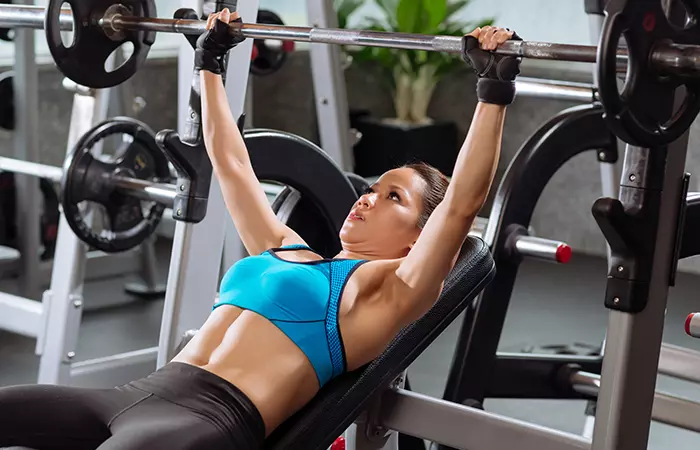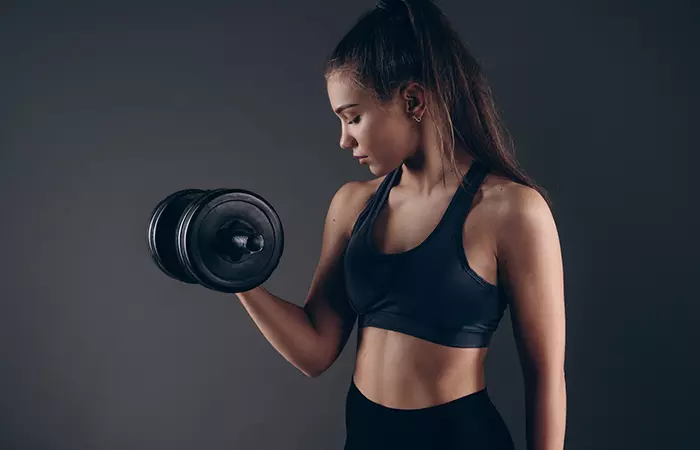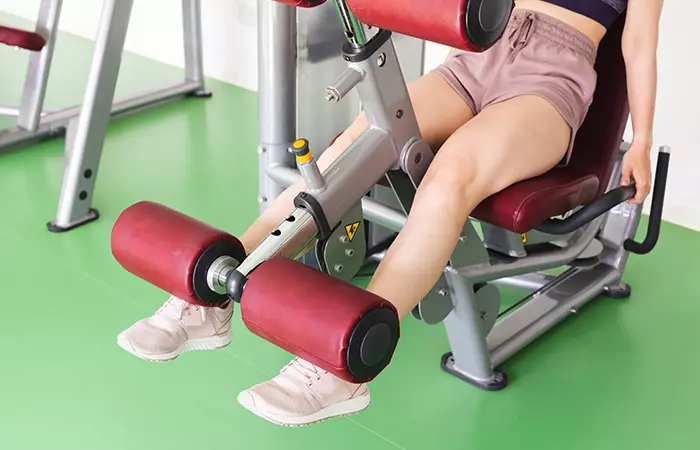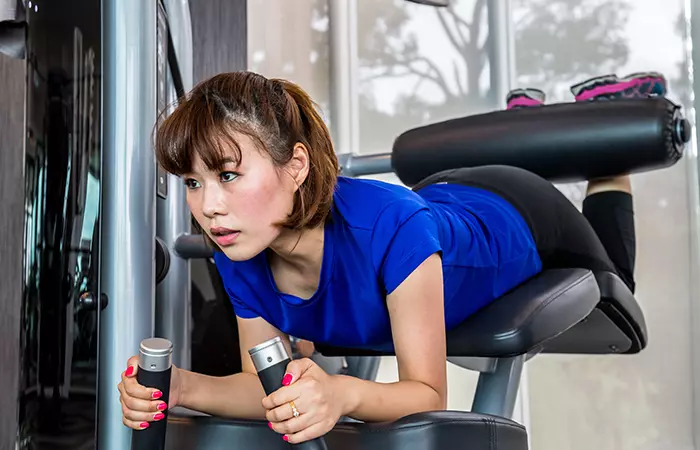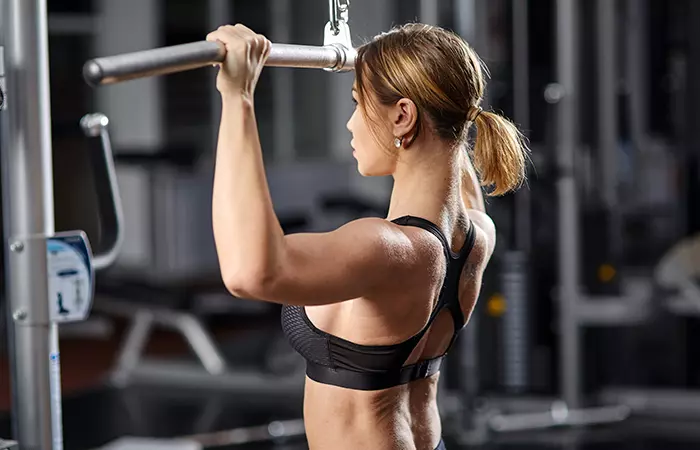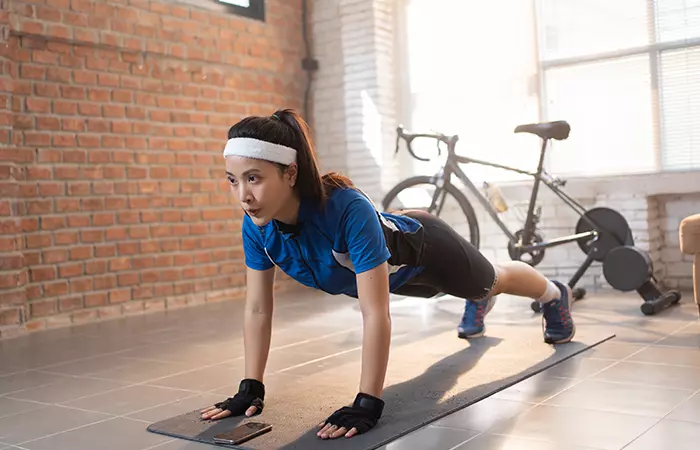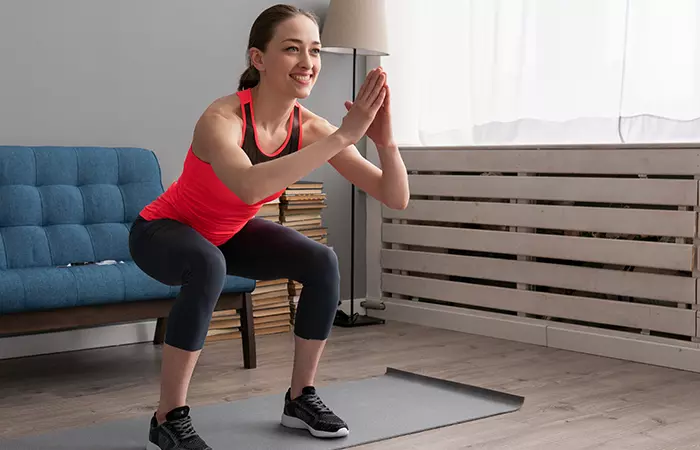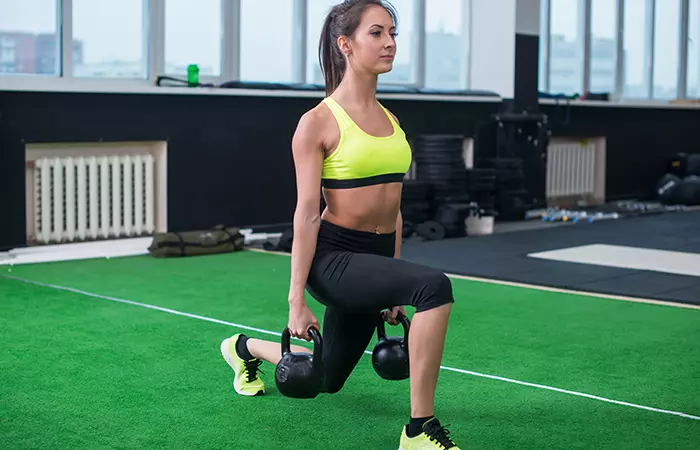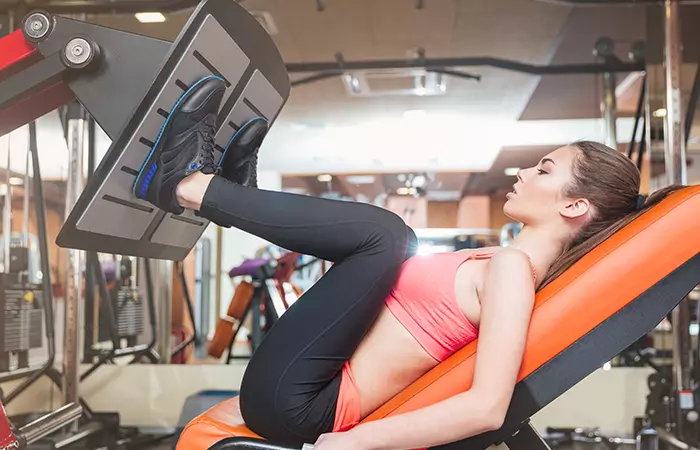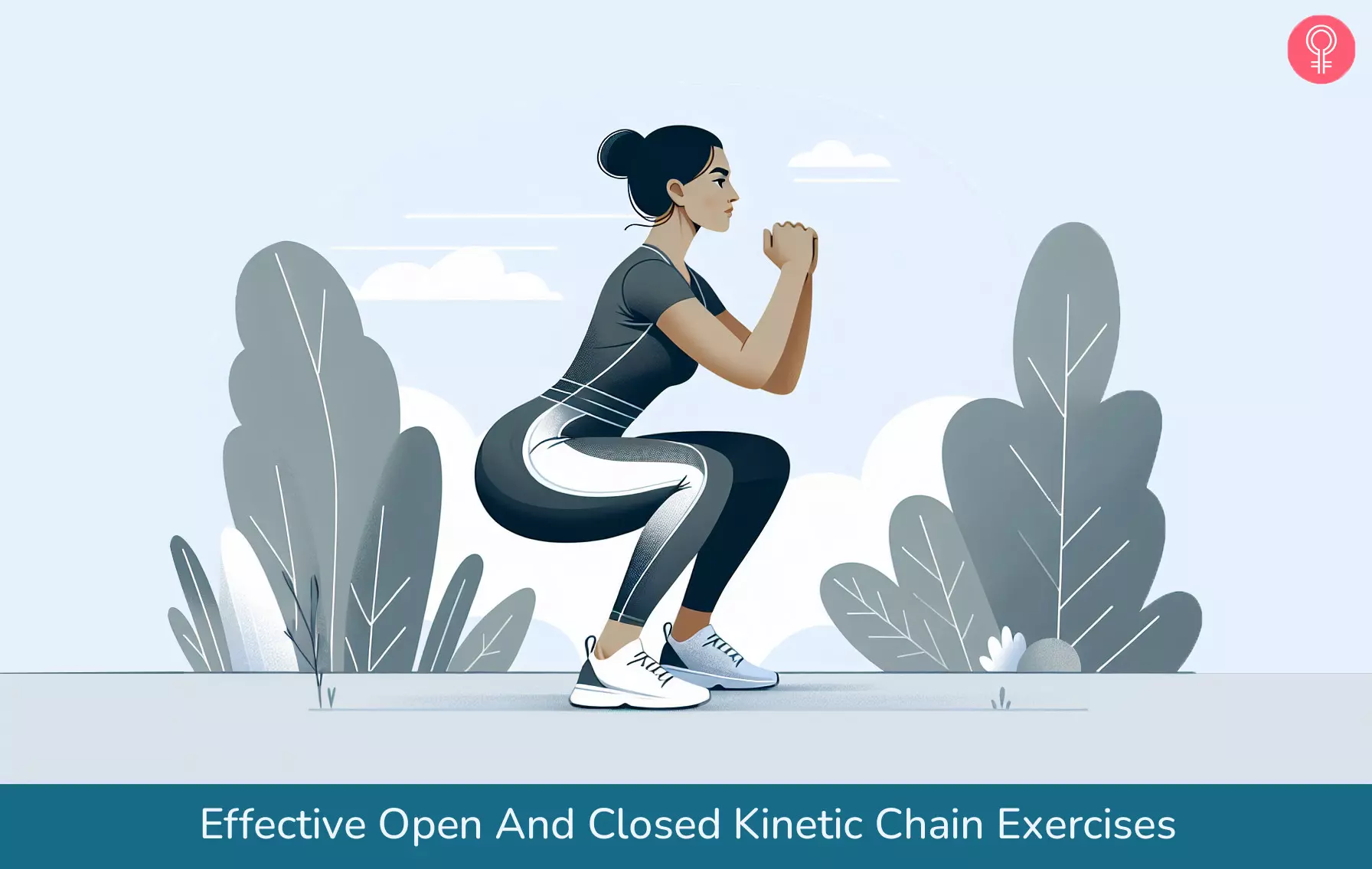Depending on how geeked-out you are about working out, you may or may not know about kinetic chain exercises. However, if you wish to level up your gym game and impress everyone around you, considering the kinetic chain is the way to go. Here’s a breakdown of these movements and how to include them in your next sweat session. Let the scrolling begin!
What Is Kinetic Chain Exercise?
Kinetic chain exercises are those movements that follow the mechanical engineering concept of kinetics. This kinetic chain notion believes that the joints and segments in our body are interrelated. The movement of one of these starts a chain reaction that affects all the neighboring joints and segments linked to it. During kinetic chain exercises, your body’s distal segments are either fixed or move freely in space. To understand the kinetic chain better, let us consider how your body moves when you perform wall throws.
Firstly, you plant your feet firmly into the ground, tighten your core, and bend your arms slightly for the exercise. Doing so helps your legs, abdomen, and arms generate a force to start the throwing motion. Ultimately, your arms move to release the ball.
All these steps occur as a chain reaction helping the exercise target the upper body muscles. It makes the moment a perfect open kinetic chain exercise.
Types Of Kinetic Chain Exercises
Kinetic chain exercises can either be “closed” or “open,” depending on the moment of the body parts farthest from the body’s center. These distal parts like your hands and feet may be fixed or free to move.
Closed-Chain Exercises
Closed kinetic chain exercises are those in which the distal points of a given limb remain fixed . In these activities, the distal parts can either be on the floor or anchored on an unmoving object like a Plyo box or a bar. Push-ups are a perfect example of kinetics exercises of this kind. When performing them, you anchor your hands and feet to the ground, and the rest of your body moves. Similarly, a pull-up is a closed-chain exercise as the hands in this activity are fixed to the bar. These exercises may or may not involve gym equipment or weights. According to a 2021 YouGov survey, bodyweight exercise, which doesn’t require any equipment or weights like in push-ups, is the most popular type of personal workout in the United States (15%) and in Britain (11%), while bodyweight exercises with weights are favored by 13% of Americans and 9% of British. Another thing about these exercises is that they are all compound movements that work on multiple muscles and joints. Therefore, they provide a higher metabolic response as more energy consumption is involved. Hence, these exercises work best for individuals wanting to improve their body composition.
Open-Chain Exercises
The exercises during which the distal point of a given limb moves freely in space are open kinetic chain exercises. For example, when you perform overhead tricep extensions, your hands do not rest on the ground or are stationary. Instead, they move the dumbbell up and down. Other open kinetic chain exercise examples include bench press and bicep curls. Unlike closed-chain exercises, these workouts are not compound movements. Instead, they work on a single joint and recruit only the muscles associated with the body part during the activity. With open-chain exercises, you can isolate and strengthen specific body areas. These exercises are a perfect choice for bodybuilders and people undergoing physiotherapy. Now, we know that there are two kinds of kinetic chain workouts. However, how different are these open and closed kinetic chain exercises? Let us take a look.
Open Vs. Closed Kinetic Chain Exercises: The Differences
Wondering what the benefits of open and closed-chain exercises are? Well, here are the major advantages of incorporating these kinetic workouts into your daily routine.
Major Benefits Of Kinetic Chain Exercises
May Improve Joint Stability
As per a study, both kinetic chain exercises provide favorable results for individuals with anterior cruciate ligament (that stabilizes the knee joint) injuries (1). Since closed-chain movements involve fixed distal ends, they emphasize joint compression and stabilize joints. Further, open-chain exercises share the load with the neighboring muscles. Numerous physical therapists use open and closed-chain exercises for kinetic chain physical therapy.
May Improve Functional Fitness
Inculcating kinetic chain exercises in your fitness routine can help you immensely with your functional fitness. Closed-chain exercises can positively impact the dynamic balance (2) needed while performing actions that require displacing oneself. Both closed and open kinetic chain movements are a part of our daily movements. Whether you are squatting down to pick up something, placing a jar on the top shelf of your pantry, or walking up the stairs, there is kinetic movement everywhere. This is why it is crucial to work on these everyday abilities that make your life better.
May Improve Muscle Strength
Functional fitness and muscle strength go hand in hand. Be it open or closed-chain exercises; both have a positive impact on muscle strength (3). Further, open-chain exercises following Anterior Cruciate Ligament reconstruction may play a crucial role in knee function (5). They target specific muscles for specific movements. This way, they help keep your activities aligned. That said, open-chain movements alone are not enough for joint stability. Your workout should be a healthy mix of open and closed-chain moments to boost kinetic chain mobility, joint and muscle health, and overall fitness.
May Improve Metabolic Rate
Closed kinetic chain exercises include everyday moments like push-ups, squats, and lunges that work on multiple muscles simultaneously . These moments require a lot of energy expenditure that, in turn, boosts the metabolic rate and helps burn fat. Further, open-chain movements work on specific muscles to strengthen them and help perform closed-chain activities better to spend extra calories.
May Promote Strength And Muscle Gain
As per a study, open and closed-chain pulley machine exercises positively impact the muscle strength of the trunk area (4). This area includes your chest, abdomen, pelvis, and back muscles. Since they help build better strength and muscles safely, kinetic chain movements are perfect for recreational athletes who wish to utilize their bodies in the best possible way for their sport. For instance, if you are a softball player, exercises that mimic the throwing motion, like wall balls and lunges with a rotation, are highly beneficial. Balancing open and closed-chain movements is the key to getting the best workout for kinetic chain strengthening. You should focus more on closed-chain exercises as they target multiple muscles simultaneously. Like every other exercise, kinetic chain exercises have certain downsides too. Keep reading to learn all about them.
Downsides Of Kinetic Chain Exercises
May Cause Wear And Tear
Open and closed kinetic chain exercises are great for planning your workout smartly. However, the most prominent mistake people tend to make is focusing only on one of these movements. For instance, if you are performing only bicep curls to build your arms, you may have better closed-chain choices. Since the movement lacks a fixed point, it lacks stability and leads to a greater chance of shoulder strain. With this, you may end up with bigger biceps. However, there is a high chance of experiencing wear and tear in the shoulder region. You can easily avoid this by ensuring that your workout plan has many closed-chain exercises with a few open-chain movements.
May Cause Joint Injuries
Performing kinetic exercises hastily and with poor posture can strain the joints, leading to injuries. It can also happen if your movements are not aligned. For instance, a bad posture can lead to badly strained knees when you perform a squat. Therefore, before you perform exercises like deadlifts and squats, ensure that your movements are well-aligned and you can hold your balance. Tests like a closed kinetic chain upper extremity stability test can also help you check the functional performance of your joints.
May Interfere With Rehabilitation
Doing closed-chain activities after an injury may interfere with the rehabilitation process after an injury. During an injury, the dysfunction of the injured area is quite normal. Performing closed kinetic chain activity during such scenarios is not a great idea due to the swelling, pain, and limited rotation of motion. Instead, you must start with open-chain movements to target and strengthen specific muscles in the injured area. If performed with care, kinetic chain movements can be a great addition to your daily schedule. Here are the best open and closed chain exercises you can easily include in your workout plan.
12 Best Open And Closed Kinetic Chain Exercises
Open Kinetic Chain Exercises
1. Bench Press
Bench press mainly targets the pectoralis major, which is the largest muscle of the anterior chest wall. This open-chain kinetic exercise also works the triceps and shoulder muscles.Moreover, the barbell exercise for women can also help increase strength and build muscles. Equipment Needed
Weight bench Barbell
How To Do
Never move the barbell too low across your neck and face to avoid unwanted injuries. Only drive it to and fro between the chest region. Avoid arching and lifting your hips off the bench to avoid back pain. Instead, keep them firmly against the bench.
2. Bicep Curls
Bicep curls target biceps brachii, brachialis, and brachioradialis, the muscles at the front of your arms. This open-chain kinetic exercise is perfect for building more arm strength. Equipment Needed
Dumbbells
How To Do Safety Tips
Avoid lifting weights too fast to avoid unwanted injuries. Instead, take your time to raise and lower the dumbbells smoothly to make the most of your time during the workout. Do not swing your shoulders to gain momentum to avoid taking the focus away from the biceps. Try maintaining a tall, upright spine, a tight core, and relaxed shoulders.
3. Seated Leg Extensions
Seated leg extensions are open-chain quad exercises. It means they work the front thigh muscles. Along with this, these also work as open-chain knee exercises by strengthening the knee ligaments. Equipment Needed
Lever machine
How To Do Safety Tips
Avoid locking your knees at full extension to avoid knee pain or strain. Instead, bend them slightly to get maximum benefits from the open-chain exercises for the knees. Going too fast during the movement will eliminate the effect of an isolation exercise. Go slow for proper muscle engagement.
4. Chest Fly
The chest fly exercise mainly targets the pectoral muscles of the chest. They also have an impact on the arms and shoulders. Equipment Needed
Dumbbells Incline bench
How To Do Safety Tips
Avoid doing this exercise in case of back, shoulder, or arm injury. It can worsen the damage even more. If you cannot move the dumbbells smoothly, consider using lighter weights. Lifting weights you cannot handle can lead to unnecessary wear and tear.
5. Hamstring Curls
Hamstring curls specifically target the back of the leg. It includes the hamstrings and calf muscles. Equipment Needed
Leg curl bench
How To Do Safety Tips
Avoid placing the roller pads too high on your calves. Doing so can put pressure on the tendons that link the heel bone to the calf muscles and reduce your range of motion. Do not perform this workout if you are recovering from a back, spine, neck, knee, or hip injury. It can worsen the condition and cause excessive pain.
6. Lateral Pull Downs
Lateral pull-downs target the Latissimus Dorsi muscle, which significantly stabilizes the neck, back, shoulders, and hips. They also work the biceps and traps to some extent. Equipment Needed
Cable pulley machine
How To Do Safety Tips
Keep your back erect while performing the movement. It will protect you from lower back injuries. Only lower the bar to the chin level. Lowering the bar further can put excessive stress on the shoulder joint and injure it.
Best Closed Kinetic Chain Exercises
7. Push Ups
One of the functional exercises, Push-ups work the chest, arms, shoulders, and core muscles. These closed-chain shoulder exercises help build both upper-body and core strength. Equipment Needed
None
How To Do Safety Tips
Avoid locking your elbows at the top of the movement, as it can lead to excessive joint strain and injury. Instead, keep them slightly bent. Do not keep your hands farther out from your body. They should be under your shoulders to avoid any negative impact on the shoulder joint.
8. Pull-Ups
Pull-ups work the upper back, neck, shoulders, and spine muscles. They help improve overall body strength and fitness levels. Equipment Needed
Pull-up bar
How To Do Safety Tips
If your chin cannot reach above the bar, do not try to force it, as it may strain your neck muscles. Instead, use an assisted pull-up machine to practice. Do not try perfecting the pull-ups as a newbie. Instead of going straight for them, try hanging from the pull-up bar for 10 to 30 seconds. It will help prevent injury and strengthen your arm and back muscles for the pull-up technique.
9. Squats
Squats are the most famous compound closed-chain exercises. They target multiple muscle groups like the glutes, calves, and quadriceps. This knee-strengthening exercise can also improve mobility of legs and make your knees more stable. Equipment Needed
None
How To Do Safety Tips
While performing the squat, your knees should always be behind your toes. Ensuring this can prevent knee and spine injuries. Always complete the range of motion of the squat to reap its full benefits. Not lowering your hip enough can also increase injury risk.
10. Lunges
Lunges are among the top closed-chain hamstring exercises. Along with the hamstrings, they also target the quads, glutes, hips, and calves. Thus, lunges help you strengthen nearly every muscle in your lower body region. Equipment Needed
Kettlebell
How To Do Safety Tips
Avoid putting too much stress on the knee during the movement. To ensure this, never let your knee joint extend the toes. Keep your balance during the movement. Losing it may rotate the back knee and injure it.
11. Deadlifts
Deadlifts are among those few compound exercises that work the entire body. The major muscles they target include the hamstrings, quadriceps, glutes, and lower back. Equipment Needed
Barbell
How To Do Safety Tips
Avoid rounding or arching the back at any point in the movement, as it may lead to back and spine injuries. Instead, keep your hips down and out to keep the back straight. Avoid using heavy weights as a beginner, as it can strain your muscles. Instead, pick up lighter weights and practice the deadlift form first.
12. Leg Press
The leg press exercise mainly focuses on the quadriceps, hamstrings, and glutes. It helps build the key muscles in your legs and makes them stronger. Equipment Needed
Leg press machine
How To Do Safety Tips
Avoid placing your hands on your knees, as it can break your form. Instead, grip the handles firmly with both hands. Do not jerk your head forward during the movement to avoid strain. Ensure it lays comfortably against the seatback.
Now, let us find out which of the two is more effective.
Closed Vs. Open Chain Exercises: Which Is More Effective?
Most gym experts and trainers often prefer closed-chain exercises as they are multi-muscle exercises in their kinetic fitness programs. Since these are compound movements, they are more effective than open-chain exercises. Irrespective of that, open-chain movements are essential. A well-designed kinetic training plan should mix both exercises with upper and lower target chains. If your fitness goals are more strength-based, have a higher ratio of closed-chain exercises in your routine for increased benefits. Alternatively, if you wish to focus on a specific muscle group to make it pop, opt for an open-chain exercise that targets it along with the closed-chain ones. Suzanne Kasparson, a blogger, shared her experience of integrating open and closed chain exercises into her workout routine on her personal blog. She writes, “As time has passed, I have learned that, while closed chain exercises have shown to be slightly more beneficial for rehabilitation and fitness goals, integrating both types of exercises have benefits (i).” What is kinetic chain control physiotherapy? Kinetic chain control physiotherapy is a body-oriented therapy that uses open and closed-chain movements to re-balance your kinetic chain. As a result, it promotes joint stability, releases tension in soft tissues, and enhances daily activities. Is walking an open-chain exercise? Open-chain exercises allow the movement of the distal ends. Since your feet move while walking, it is an open-chain exercise. It is also considered as one of the best weight-bearing exercises. Is swimming an open or closed-chain exercise? Swimming is a mix of open and closed-chain exercises. In it, every movement except the beginning and end are open-chains. Is yoga a closed-chain exercise? Yes, yoga is a closed-chain exercise. Most yoga asanas require a position with the distal ends of the body fixed. Are isometric exercises closed chain? Yes, isometric exercises are a type of closed kinetic chain exercise in which the muscles contract without changing their length, and the joint angle remains constant. These exercises are often used for static strength training and can be performed with or without external resistance. Isometric exercises are beneficial for improving muscle endurance, stability, and proprioception. Examples of isometric exercises include planks, wall sits, and glute bridges. Are stability exercises open or closed chain exercises? Stability exercises are closed kinetic chain exercises that focus on improving balance, coordination, and joint stability. These exercises are often used in rehabilitation settings to prevent injuries and improve functional performance. Examples of stability exercises include single-leg balance, Bosu ball exercises, and stability ball exercises. Are proprioceptive exercises considered closed chain exercises? Yes, proprioceptive exercises are closed kinetic chain exercises that aim to improve proprioception, which is the body’s ability to sense its position and movement in space. Proprioceptive exercises are often used in rehabilitation programs to improve joint stability, balance, and coordination. Examples of proprioceptive exercises include balance boards, wobble boards, and foam pad exercises.
Illustration: Effective Open And Closed Kinetic Chain Exercises
Learn how to strengthen your quadricep muscles with this easy-to-follow video tutorial. Get ready to improve your strength and mobility with these physio exercises!
